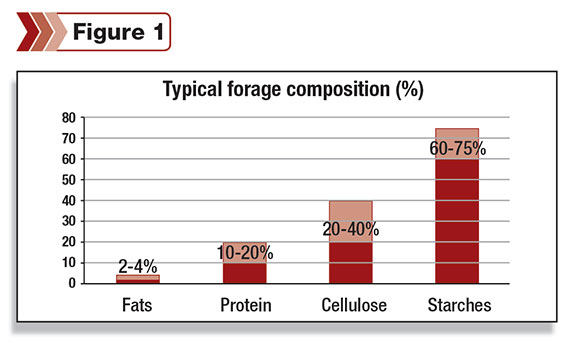Many of us have heard the suggestions to use direct-fed microbials (DFM) supplements, also known as probiotics, on calves soon after birth. There is a good reason for this suggestion.
Newborns are born with a sterile gut, but bacteria quickly start colonizing the intestine during the first days of life. The key is to make sure the right probiotic bacteria start colonizing the intestinal tract instead of pathogenic organisms.
If that occurs, then optimal performance gains will occur more readily. Stress induced by weaning, transportation, changes in diet or weather, or treatment with antimicrobials can negatively affect the normal microflora in the intestine.
When normal intestinal microflora is impaired, intestinal defensive mechanisms are upset, making the calf more susceptible to disease. It is at this point that DFMs can have a great influence.
To maintain normal health and production, DFMs can produce organic acids – lactic, acetic or butyric – which lower intestinal pH and inhibit growth of potential pathogens like E. coli and salmonella.
Some species of bacteria produce special antimicrobial compounds called bacteriocins, which inhibit the growth of pathogens in the intestine. The DFMs can then colonize the GI tract faster than pathogens through mechanisms known as competitive exclusion.
Research also suggests that intestinal bacteria improve the barrier effect of intestinal mucosa and interact directly with the immune system, strengthening the system and protecting the calf against pathogen invasion.
Perhaps no bacteria are more common in probiotics than Bacillus subtilis. This bacterium is often used, as the spores it produces resist heat and other environmental extremes.
It has been shown to perform the functions of production of antimicrobial metabolites and competitive bacterial exclusion interactions. Bacillus subtilis is also involved in mucosal conditioning and immune modulation.
Enzymes produced by DFMs and produced by microbial fermentation
DFMs can also produce enzymes that play a beneficial role in digestion of feeds. Enzymes are proteins that catalyze (facilitate) chemical reactions in biological systems.
Enzymes are essential in the digestion of feeds into their chemical components (e.g., glucose, amino acids), which are in turn used by rumen microbes or directly by the cow.
Most enzymes are highly specific, breaking distinct chemical bonds within their substrates and, therefore, the complete digestion of a complex feed such as alfalfa hay requires the activity of literally hundreds of unique enzymes.
DFM enzymes can help digest forages by increasing the rate at which fiber is hydrolyzed and digested. Enzymes are also produced during microbial fermentation processes and added into forages.

As can be seen in Figure 1 , typical forage is very high in starch and cellulose.
This requires an appropriate mixture of enzymes and other metabolites in order to digest or hydrolyze all these components.
Having a mix of DFMs and added enzymes from microbial fermentations can help optimize forage digestion.
Some DFMs also affect feed digestion by acting on certain rumen microbes. In this reaction, the profile of rumen-volatile fatty acids is changed, as is the rumen-protein digestion.
It lowers rumen-acetate level and increases propionate and butyrate levels. It reduces the breakdown of amino acids in the rumen, and thus lowers rumen ammonia-nitrogen levels.
These modes of action explanations for DFMs are backed up by real performance gains under both experimental research situations and actual production conditions.
For example, research in the 1990s reported that performance was improved (decreased scouring and improved growth) when probiotic bacteria (Lactobacillus acidophilus and Bifidobacterium pseudolongum) were fed.
Researchers in 2005 fed two different direct-fed microbial formulations to 1-week-old to 2-week-old veal calves in four different experiments.
Results from all four experiments suggested that direct-fed microbials increased growth and feed efficiency in calves during the first two weeks. This appeared to be especially true when calves were stressed and disease incidence was significant.
Researchers from 1980 reported that feeding L. acidophilus to calves decreased the content of fecal coliforms, which may be related to presence of scours.
Finally, in 2008, it was suggested that a novel direct-fed microbial (Propionibacterium jensenii 702) resulted in greater bodyweight gain, not only during the milk feeding period (the bacterium was added to milk), but also after weaning.
Because of positive results seen with DFMs, more research is being funded at significant levels. Recently, www.meatingplace.com reported that research is taking the DFM approach to try to eradicate salmonella in poultry by using modified bacteria that already live in the intestines of chickens.
Microbiologists are using a $2.5-million USDA grant to identify and expand the presence of microbiomes that populate animal intestines including viruses, bacteria and fungi.
The goal of the five-year project is to encourage the presence of bacteria that can exclude salmonella and reduce the risk that poultry and raw eggs pass along salmonella to humans.
An estimated 42,000 cases of salmonella infection are reported annually in the U.S., with about 400 of those infected dying from the infection. Clearly it is in everyone’s interest to reduce these infections and DFM use may offer a key to this.
Practical considerations when using direct-fed microbials on-farm
• Strain selection – Most published research has been conducted with well-defined individual strains or limited combinations of bacteria. Most modern direct-fed microbial products are combinations of several bacteria and sometimes yeast.
This is because different microbes can produce different metabolites, including different enzymes and also perform in somewhat different manners in the animal.
Further, different strains of specific organisms (e.g. Lactobacillus acidophilus) may respond differently to other strains in the intestinal environment. When choosing a DFM, select companies that have research on specific organisms in the product.
• Storage – All direct-fed microbial products contain living organisms. Therefore, the manner in which products are manufactured, shipped, stored and handled is very important.
Conditions that can kill direct-fed microbials include storage for long periods, high temperatures, low temperatures, direct sun, high humidity, oxygen, presence of mineral premixes and others.
Over time, organisms will die and product effectiveness will be lost. The take-home message is to be sure to follow the manufacturer’s recommendations for storing direct-fed microbial products.
• Water – High levels of chlorination, high or hot temperature (more than 130ºF) and mineral content of water may also dramatically affect viability of direct-fed microbials. The take-home message is to be aware of what is in your water when using DFMs.
• Mixing with milk replacer – Be sure to follow the manufacturer’s recommendations on including in milk replacer, since high water temperatures used with some milk-replacer formulations (particularly those used in the veal industry) may kill some direct-fed microbial products.
• Antimicrobials – Antimicrobials in milk replacer or waste milk may interfere with the action of direct-fed microbial products. In addition, use of ionophores may interfere with the action of some direct-fed microbial products.
• Pasteurization – All direct-fed microbial products should be added to waste milk only after pasteurization and after the milk has cooled to feeding temperature.
Work with your nutritionist or advisers to choose DFMs. This will help turn the suggestions into concrete ideas for optimizing production and gain at your operation. PD
Whitten is a veterinarian with 27 years of private practice experience and several years as a nutritional consultant. He currently is employed by Vets Plus as a technical field support veterinarian.
References omitted due to space but are available upon request. Click here to email an editor.

Tom Whitten
Technical Field Support Veterinarian
Vets Plus







